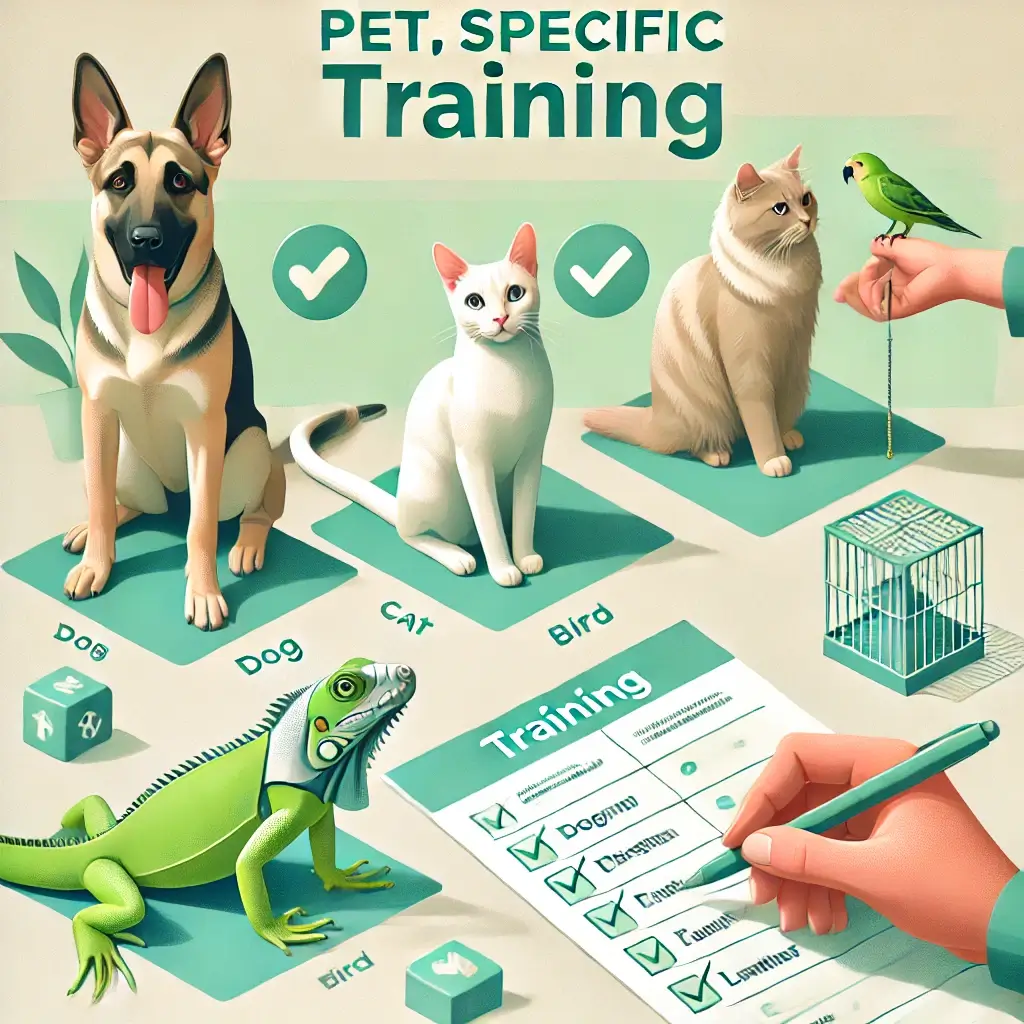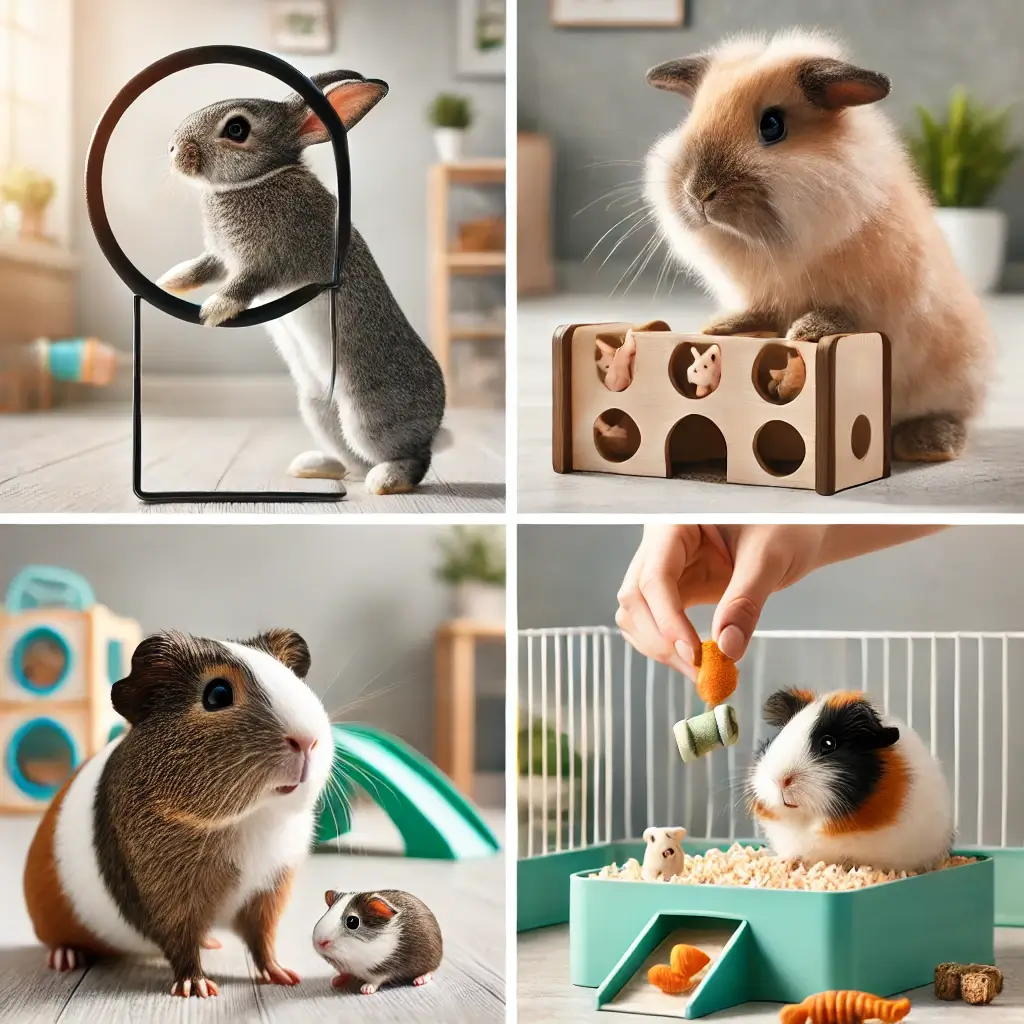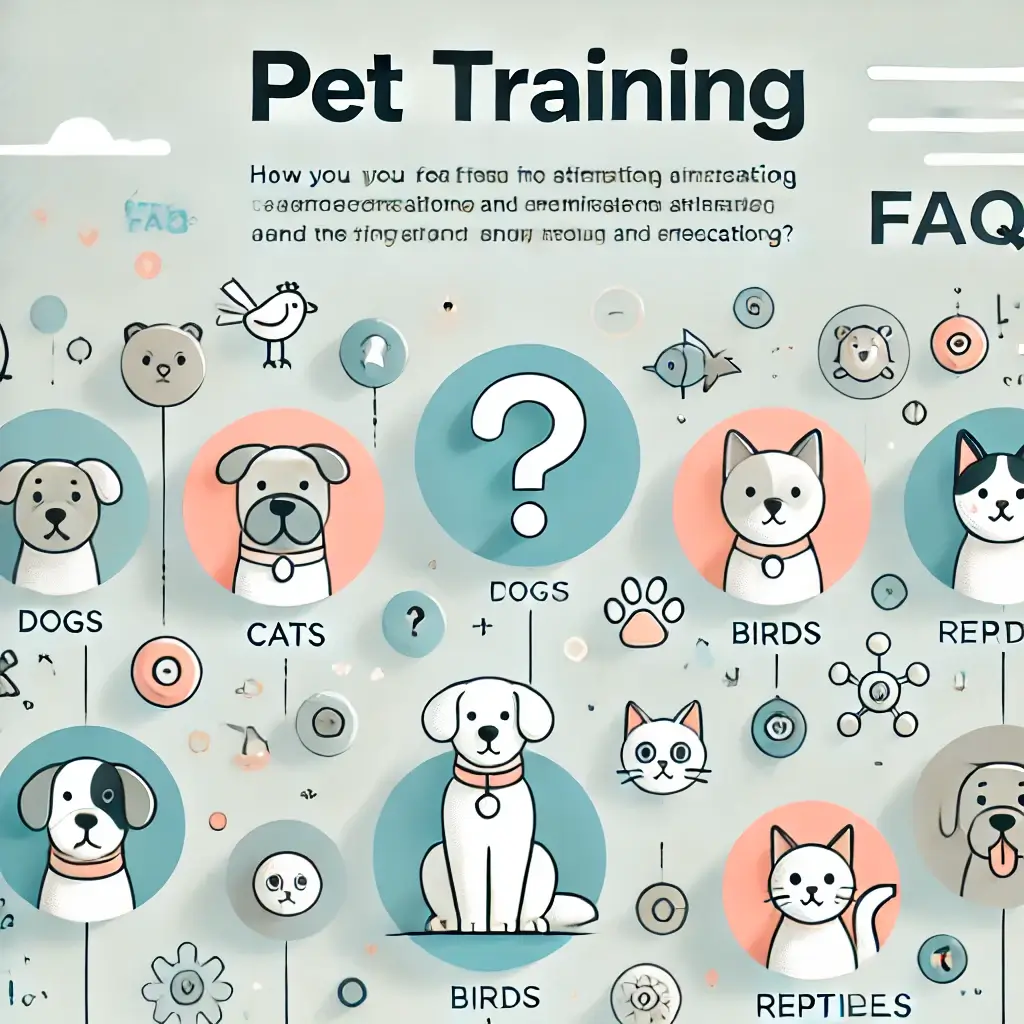Training pets is one of the best ways to create a strong bond and improve their behavior. Every pet, whether a dog, cat, bird, or reptile, has unique traits that require tailored approaches.
Training articles by pet type help pet owners understand these differences and offer specific methods for success. A dog might need help with obedience. A cat’s training could focus on litter box habits or reducing scratching. Birds often need trust-building for vocal training. Reptiles enjoy safe handling. Tailored techniques yield the best results. They address each pet’s instincts and behaviors.
This guide provides free training articles by pet type for pet owners looking for reliable and actionable advice. Whether you’re dealing with a stubborn puppy, a curious parrot, or a timid hamster, these tips will help. You’ll also discover the tools and supplies needed for effective training, such as clickers, leashes, and positive reinforcement techniques.
Also Read
Training isn’t about teaching tricks. It’s about creating a happy, healthy environment for your pet. The right approach will yield progress and build trust and understanding. Let’s explore effective methods for training pets, starting with the basics.
Why Pet-Specific Training Matters

Training a pet is more than teaching commands. It’s about building trust, improving behavior, and ensuring their well-being. However, generic training methods don’t always address the unique needs of different pets.
This is where pet-specific training becomes crucial. It customizes its methods to suit the natural behaviors and learning styles of dogs, cats, birds, reptiles, and other pets.
1. Why Generic Training Fails
Generic training methods often overlook species-specific needs. For example:
- Dogs thrive on routines and positive reinforcement, but these methods may not work with cats.
- Cats are independent and require motivational training, unlike the social approach used for dogs.
- Birds respond to trust-building exercises that enhance their ability to vocalize and interact.
- Reptiles need handling practices that reduce stress and ensure safety.
2. Benefits of Pet-Specific Training
| Benefit | Impact on Pets |
|---|---|
| Behavioral Adjustment | Reduces aggression, anxiety, and destructive habits. |
| Enhanced Learning | Speeds up training by aligning with natural instincts. |
| Stronger Bond | Builds trust and understanding between pets and owners. |
By tailoring training, pets learn more effectively, making them happier and healthier.
3. Examples of Tailored Training
- Dogs: Teaching obedience through commands like “sit” or “stay.”
- Cats: Using clicker training to reinforce good behavior.
- Birds: vocal training to mimic words or tunes.
- Reptiles: Gradual handling techniques to build trust.
4. Expert Insights
The American Veterinary Society of Animal Behavior says custom training boosts a pet’s health. Studies show that pets trained with species-specific methods are 60% more likely to remember what they learn (source link example).
Visual Aid: Training Success by Pet Type
| Pet Type | Success Rate with Tailored Training (%) |
|---|---|
| Dogs | 85% |
| Cats | 70% |
| Birds | 65% |
| Reptiles | 50% |
External Link
Learn more about species-specific training methods at ASPCA Training Resources.
Affiliate Recommendations
- Dog Training Supplies: Buy now.
- Clickers for Cat Training: Shop here.
- Reptile Handling Tools: Explore options.
Dog Training Articles

Training a dog is essential for fostering good behavior and building a lifelong bond. Dogs are smart, social animals. They thrive when they know their roles and limits. The right training techniques are key to success. Use them to teach a puppy basic commands or to help an older dog correct bad habits.
1. The Importance of Dog Training
Training helps dogs. It lets them adapt to house rules, interact with others, and improve their mental health. It reduces common issues like barking, jumping, or leash pulling, making life easier for both dogs and their owners. Studies show that trained dogs are less prone to anxiety and behavior issues (source link example).
2. Basic Dog Training Tips
Here are the most common training tips for beginners:
- Positive Reinforcement: Reward good behavior with treats, praise, or toys.
- Consistency: Use the same commands and gestures each time to avoid confusion.
- Short Sessions: Keep training sessions to 10-15 minutes for better focus.
- Patience: Dogs learn at different speeds, so celebrate small successes.
3. Types of Dog Training
| Type | Purpose | Example Commands |
|---|---|---|
| Obedience Training | Basic manners and commands | Sit, Stay, Come |
| Behavioral Training | Correcting negative behaviors | No Barking, No Jump |
| Socialization Training | Improving interaction with people and pets | Calm Greetings |
| Agility Training | Physical challenges and advanced tasks | Weave, Jump, Run |
Obedience training is an excellent starting point for all dogs, while agility training can be introduced to active breeds.
4. Tools for Effective Training
- Clicker: Reinforces positive behavior with a consistent sound.
- Leash and Harness: Essential for leash training and ensuring control.
- Treat Pouch: Keeps rewards accessible during training sessions.
5. Common Dog Training Mistakes
- Inconsistency: Switching between commands confuses dogs.
- Harsh Punishments: Using negative reinforcement can cause fear and anxiety.
- Skipping Socialization: Dogs need exposure to different environments, people, and other animals early on.
Affiliate Recommendations
- Clickers for Training: Shop here.
- Durable Leash and Harness Set: Buy now.
- Healthy Dog Treats: Explore options.
Visual: Dog Training Success Rates
Visual: Dog Training Success Rates
| Training Type | Average Success Rate (%) |
|---|---|
| Obedience Training | 90% |
| Behavioral Training | 75% |
| Agility Training | 80% |
| Socialization Training | 85% |
External Link
For more dog training tips, visit American Kennel Club Training Resources.
Training is an investment in your dog’s happiness and your relationship. With patience and custom methods, you can teach your dog. You can teach it everything from basic commands to advanced tricks.
Cat Training Articles

Cats are often misunderstood as untrainable animals due to their independent nature. However, with the right approach, cats can be trained to adopt positive behaviors and even learn tricks. Tailored cat training techniques ensure that their natural instincts are respected while guiding them toward desired habits.
1. Why Train Your Cat?
Training improves a cat’s life. It reduces stress, stimulates the mind, and prevents destructive behavior. It also strengthens the bond between you and your feline companion. Simple techniques can fix common problems. These include scratching furniture and avoiding the litter box.
2. Basic Cat Training Tips
- Positive Reinforcement: Use treats, toys, or praise to reward good behavior.
- Consistency: Stick to the same commands and gestures during training.
- Timing: Train during moments when your cat is calm and attentive, not hungry or tired.
3. Essential Training Areas
| Training Goal | Method | Tools |
|---|---|---|
| Litter Box Training | Place the box in a quiet, accessible spot. | Scent attractants |
| Stop Scratching Furniture | Redirect to scratching posts. | Scratching posts, sprays |
| Teaching Tricks | Use a clicker to signal desired behaviors. | Clicker, treats |
4. Advanced Training Techniques
- Clicker Training: A small sound-making device helps associate a click with a reward. For example, click when the cat sits and follow it with a treat.
- Leash Training: Introduce a harness slowly, allowing the cat to get comfortable before practicing short walks indoors.
- Behavior Redirection: For negative behaviors like jumping on counters, provide alternatives like cat trees or designated play areas.
5. Common Mistakes in Cat Training
- Punishing Bad Behavior: Cats don’t respond well to punishment; it can create fear or aggression.
- Inconsistent Rewards: If rewards are delayed or skipped, cats may not associate the action with the treat.
- Ignoring Their Mood: Training when a cat is stressed or distracted often leads to frustration for both pet and owner.
Affiliate Recommendations
- Interactive Cat Toys: Buy now.
- Clicker for Training: Shop here.
- Durable Scratching Posts: Explore options.
Visual Aid: Cat Training Success by Activity
| Training Activity | Success Rate (%) |
|---|---|
| Litter Box Training | 90% |
| Stopping Scratching | 75% |
| Teaching Basic Tricks | 60% |
External Link
Explore more about cat training techniques at ASPCA Cat Training Resources.
Bird Training Articles

Training birds is rewarding. It builds their trust and tests their smarts. Unlike mammals, birds need special training. It must suit their social and vocal natures. Parrots, finches, canaries, and other species can all enjoy training sessions. They should focus on good behavior and interaction.
1. The Benefits of Bird Training
Training helps birds build confidence, reduce stress, and enhance their social skills. It also curtails destructive behaviors, such as excessive screeching or feather plucking. Birds, particularly parrots, thrive on mental stimulation, making training essential for their well-being.
2. Basic Bird Training Techniques
| Training Method | Steps to Success |
|---|---|
| Step-Up Command | Encourage the bird to step onto your hand with a treat. |
| Trust Building | Spend time near the bird without making sudden movements. |
| Target Training | Use a stick or wand to guide their movements. |
3. Teaching Birds to Talk
- Repetition: Repeat words or phrases consistently to help birds mimic them.
- Positive Reinforcement: Reward attempts at vocalization with treats or praise.
- Engage Daily: Interact frequently, focusing on clear and simple words.
Parrots, like African greys and macaws, excel at learning words and mimicking sounds.
4. Handling and Trust Building
Gaining a bird’s trust is foundational to training.
- Approach the bird calmly and avoid sudden movements.
- Offer treats from your hand to create a positive association.
- Practice short, consistent sessions to build familiarity.
5. Common Bird Training Mistakes
- Overly Long Sessions: Birds have short attention spans; limit training to 10-15 minutes.
- Inconsistent Commands: Stick to the same words and gestures.
- Neglecting Socialization: Birds need regular interaction to remain social and stress-free.
Affiliate Recommendations
- Parrot Training Clicker: Shop here.
- Interactive Bird Toys: Explore options.
- Perches for Training: Buy now.
Visual Aid: Bird Training Success by Activity
| Training Activity | Success Rate (%) |
|---|---|
| Step-Up Command | 85% |
| Teaching Words | 60% |
| Target Training | 75% |
External Link
Learn more about bird training techniques at Pet Bird Training Resources.
Reptile Training Articles

Reptiles are fascinating and unique pets that often need specialized training and care. Reptiles, unlike mammals or birds, rely on instincts and cues. So, training them is more about trust and handling than obedience. To train a turtle, lizard, or snake, first understand their behavior.
1. The Importance of Reptile Training
Reptile training focuses on:
- Building trust to reduce stress during handling.
- Ensuring safety for both the reptile and the handler.
- Encouraging natural behaviors such as following targets or responding to feeding cues.
Training helps reptiles adapt to captivity. It makes interactions safer and more enjoyable for owners.
2. Basic Reptile Training Tips
- Start Slow: Reptiles need time to acclimate to their environment and you.
- Use Target Training: A stick or pointer helps guide their movement.
- Reward Positive Behavior: Use food as a motivator, such as worms or fruit slices.
3. Handling Techniques
| Reptile Type | Handling Tips | Training Focus |
|---|---|---|
| Turtles | Hold the shell gently but securely. | Target following, feeding |
| Bearded Dragons | Support the belly and tail. | Hand-feeding, climbing cues |
| Snakes | Avoid sudden movements; support their body evenly. | Trust-building, feeding cues |
Handling is key to reducing a reptile’s stress. It also ensures safety during interactions.
4. Advanced Training Techniques
- Target Stick Training: Guide turtles or lizards to follow a stick to a specific spot for rewards.
- Habituation to Handling: Gradually increase handling time to help reptiles feel secure.
- Climbing and Enrichment: Use branches or rocks to encourage natural behaviors.
5. Common Reptile Training Mistakes
- Rushing the Process: Reptiles take longer to adjust; patience is key.
- Ignoring Environmental Needs: Proper lighting, humidity, and temperature are essential for reptiles’ well-being.
- Overhandling: Too much handling can stress reptiles, causing them to retreat or become defensive.
Affiliate Recommendations
- Target Training Sticks: Shop here.
- Feeding Tongs: Buy now.
- Reptile Habitat Setup: Explore options.
Visual Aid: Reptile Training Success by Type
Visual Aid: Reptile Training Success by Type
| Reptile Type | Training Success Rate (%) |
|---|---|
| Turtles | 70% |
| Bearded Dragons | 80% |
| Snakes | 60% |
External Link
For more reptile training tips, visit Reptile Training Resources.
Small Pets and Rodents Training

Training small pets, like rabbits,guinea pigs, and hamsters, is rewarding. It engages their curiosity and builds a stronger bond. These pets may lack the trainable instincts of dogs or cats. But, with patience and positive reinforcement, they can learn simple tricks and behaviors.
1. Why Train Small Pets?
Training small pets improves their lives. It stimulates their minds and reduces boredom. It also helps them feel more at home. This leads to better interactions with their owners. For example:
- Rabbits can be taught to use a litter box.
- Guinea pigs can respond to their names and follow simple commands.
- Hamsters can learn tricks, such as navigating mazes.
2. Basic Training Tips for Small Pets
- Positive Reinforcement: Reward good behavior with small treats like vegetable pieces or pet-safe snacks.
- Short Sessions: Keep sessions to 5–10 minutes to match their attention spans.
- Be Patient: Progress may be slow, but consistency is key to success.
3. Common Training Goals
| Pet Type | Training Goal | Tips and Tools |
|---|---|---|
| Rabbits | Litter box training | Use a shallow box with hay |
| Guinea Pigs | Responding to names | Call their name during treat time |
| Hamsters | Trick training (e.g., maze) | Use small mazes and reward treats |
4. Advanced Tricks
- Hoop Jumping: Encourage rabbits to hop through a hoop with treat lures.
- Following Commands: Teach Guinea Pigs to follow a target stick.
- Maze Navigation: Create a simple toy maze for hamsters to explore.
5. Mistakes to Avoid
- Rushing the Process: Small pets require time to learn; forcing behaviors leads to stress.
- Overfeeding Treats: Balance training rewards with a healthy diet.
- Ignoring Body Language: Signs of stress include freezing or hiding; stop training if these occur.
Affiliate Recommendations
- Interactive Toys for Small Pets: Shop here.
- Rabbit Litter Boxes: Explore options.
- Small Pet Mazes: Buy now.
Visual Aid: Training Success by Small Pet Type
| Pet Type | Training Success Rate (%) |
|---|---|
| Rabbits | 80% |
| Guinea Pigs | 70% |
| Hamsters | 60% |
External Link
Learn more about small pet training at Small Pet Training Resources.
Essential Tools to Make Pet Training Easier

The right tools can greatly improve pet training. They can enhance communication, reinforce behaviors, and make learning more engaging. Here’s a list of tools tailored for various pet types and training goals:
1. Clicker
- What It Does: Produces a consistent sound to mark the correct behavior.
- Best For: Dogs, cats, birds, and small pets.
- How It Helps:
- Provides immediate feedback during training.
- Simplifies communication between you and your pet.
- Example: Click the device when a dog sits, followed by a treat.
2. Treat Pouch
- What It Does: Stores training treats for easy access during sessions.
- Best For: All pets.
- How It Helps:
- Keeps treats within reach, avoiding disruptions during training.
- Helps maintain focus and reinforce positive behavior consistently.
3. Target Stick
- What It Does: Guides pets’ movements during training.
- Best for: birds, reptiles, and small pets.
- How It Helps:
- Teach pets to follow the stick to specific locations or to perform actions.
- Encourages interaction and builds trust.
4. Training Harness and Leash
- What It Does: Provides control during leash training or outdoor sessions.
- Best For: Dogs and even cats.
- How It Helps:
- Ensures safety and minimizes pulling or resistance.
- Helps to teach proper walking behavior.
5. Puzzle Toys
- What They Do: Offer mental stimulation and enrichment.
- Best For: Dogs, cats, birds, and small pets.
- How They Help:
- Reduce boredom and destructive behavior.
- Reward problem-solving with treats or interactive elements.
6. Treats
- What They Do: Motivate pets to learn and reinforce good behavior.
- Best For: All pets (adjust treats based on pet type).
- How They Help:
- Positive reinforcement encourages pets to repeat desired behaviors.
- Easily customizable for size and dietary needs.
7. Training Mats or Pads
- What They Do: Provide a designated training area for activities.
- Best For: Dogs, cats, and small pets.
- How They Help:
- Set boundaries for specific behaviors, such as sitting or staying.
- Assist with housebreaking and potty training.
8. Noise-Making Toys
- What They Do: Attract and maintain your pet’s attention during training.
- Best For: Dogs, birds, and small pets.
- How They Help:
- Keep pets engaged during longer sessions.
- Double as rewards for completed tasks.
9. Litter Boxes with Attractants
- What They Do: Encourage pets like cats or rabbits to use the litter box.
- Best for: cats, rabbits, and other small pets.
- How They Help:
- Simplifies litter training by drawing pets to the box.
- Reduces accidents and ensures hygiene.
10. Feeding Tongs
- What They Do: Offer a safe way to feed reptiles during handling training.
- Best For: Reptiles.
- How They Help:
- Prevents bites or accidents during feeding.
- Builds trust by associating the handler with positive experiences.
11. Perches
- What They Do: Provide birds with a safe and stable place for training.
- Best For: Birds.
- How They Help:
- Encourage birds to step up or perform tricks in a familiar setting.
- Improve balance and confidence during training.
12. Training Books or Online Courses
- What They Do: Offer expert advice and structured programs.
- Best For: Owners seeking professional guidance.
- How They Help:
- Provide step-by-step instructions for specific training goals.
- Expand your knowledge of species-specific techniques.
Affiliate Recommendations
- Clickers for Training: Buy here.
- Treat Pouches: Shop now.
- Target Sticks: Explore options.
Summary Table of Tools by Pet Type
| Tool | Best For | Use Case |
|---|---|---|
| Clicker | Dogs, Cats, Birds | Marking correct behavior |
| Target Stick | Birds, Reptiles | Guiding movements |
| Leash & Harness | Dogs, Cats | Walking training |
| Puzzle Toys | All pets | Mental stimulation |
| Feeding Tongs | Reptiles | Safe feeding during training |
| Perches | Birds | Stability during tricks |
Tips for Using Tools Effectively
- Introduce Gradually: Allow your pet to get comfortable with each tool before using it in training.
- Pair with Rewards: Combine tools with treats or praise to reinforce positive associations.
- Monitor Progress: Adjust tools and methods based on your pet’s response.
Building a Better Bond Through Tailored Pet Training

Training your pet is a great way to improve their life. It also strengthens your bond. Every pet has unique traits and behaviors that need tailored methods for success. Training articles by pet type provide the perfect starting point for understanding how to approach training for dogs, cats, birds, reptiles, and small pets.
Why Tailored Training Matters
Generic training methods often fall short when applied to pets with varying needs. Dogs, for example, respond well to positive reinforcement training that incorporates treats and praise. On the other hand, cats are motivated by curiosity, making clicker training a more effective tool.
For birds, target stick training helps them learn to perch, vocalize, or follow directions, while reptiles require slow, steady handling to reduce stress and build trust.
Each method caters to the pet’s natural instincts. Train your pet using its instincts. This will create a fun, effective system.
Tools to Make Training Easier
Using the right tools can make training more efficient and engaging.
- Clickers: Perfect for marking good behavior in dogs, cats, and birds.
- Puzzle Toys: Provide mental stimulation for small pets and keep them focused.
- Target Sticks: Ideal for guiding birds and reptiles during training sessions.
These tools are simple to use and widely available, helping pet owners at all experience levels.
Common Challenges and How to Overcome Them
Training can be challenging, especially if your pet is shy or stubborn. Here’s how to tackle common issues:
- Inconsistent Progress: Stick to a routine and ensure everyone in your household uses the same commands.
- Lack of Engagement: Shorten sessions and use high-value rewards to keep your pet interested.
- Stress or Fear: Create a calm, safe environment and move at your pet’s pace.
These small adjustments can lead to significant improvements over time.
A Rewarding Journey
Training isn’t about teaching tricks or commands. It’s about building a trusting, understanding relationship. With free training articles by pet type, you have access to resources that help you learn what works best for your specific companion.
Leash-training a dog, teaching a bird to step up, or litter-training a rabbit? Every success strengthens your bond with your pet. Be patient, consistent, and understanding. It will make the training process fun and rewarding for you both.
More Tips: Insights into Pet Training Techniques
Training your pet can feel overwhelming, but with the right resources, you can make the process enjoyable and effective. Accessing training articles by pet type pdf files and free training articles by pet type is a great starting point to understand the specific needs of your pet.
These resources offer actionable insights tailored to various animals, from dogs and cats to birds and small pets.
Exploring the 4 Types of Dog Training
Dog training comes in many forms, but the 4 types of dog training stand out as essential for building a well-behaved companion:
- Obedience Training: Teaches basic commands like “sit” or “stay.”
- Behavioral Training: Addresses issues like barking or aggression.
- Socialization Training: Helps dogs interact positively with other animals and people.
- Agility Training: Focuses on physical activities and advanced tricks.
For each of these, having the right dog training supplies, like leashes, clickers, and treats, is critical for success.
Practical Tips for Beginners
If you’re new to pet training, start small. Dog training tips for beginners often emphasize patience and positive reinforcement. Use rewards like treats or toys to encourage good behavior, and keep sessions short to maintain your pet’s focus. Free resources, such as scholarly articles on dog training, can help you deepen your understanding of effective methods and why they work.
The Financial Side of Dog Training
Understanding the cost of training can help you make informed decisions:
- Dog Trainer Salary: Depending on experience and location, trainers can earn between $30,000 and $70,000 annually, reflecting the value of their expertise.
- Dog Training Fees: Group classes often cost between $30 and $80 per session, while private sessions can range from $100 to $200 per hour.
While professional training services come with a price, DIY methods with the help of training articles by pet type pdf can be an affordable alternative for dedicated owners.
Training doesn’t just create well-behaved pets; it builds trust, strengthens your bond, and improves their quality of life. Whether you’re diving into free training articles by pet type or investing in professional guidance, the right approach ensures a happier, healthier companion for years to come.
Pros and Cons of Pet Training
Training your pet is rewarding. It strengthens your bond and improves their life. But it comes with both advantages and potential challenges. Below is a comprehensive overview of the pros and cons of pet training to help you understand its impact.
Pros of Pet Training
1. Improved Behavior
- Benefit: Training reduces unwanted behaviors such as barking, scratching, biting, or jumping.
- Example: A dog trained to obey commands is less likely to pull on the leash or bark excessively.
2. Strengthened Bond
- Benefit: Spending time training your pet creates trust and understanding.
- Example: Teaching a cat to respond to its name fosters better communication.
3. Increased Safety
- Benefit: Training enhances safety for both the pet and owner.
- Example: Recall training ensures your dog comes back when called, reducing the risk of accidents.
4. Mental Stimulation
- Benefit: Training exercises challenge your pet’s mind, preventing boredom and related destructive behaviors.
- Example: Birds trained to solve puzzles stay active and engaged.
5. Socialization Benefits
- Benefit: Training, especially in group settings, helps pets become comfortable around people and other animals.
- Example: A well-socialized dog is less likely to show aggression toward strangers or other dogs.
6. Better Quality of Life
- Benefit: Trained pets are often happier and healthier because they feel secure and understood.
- Example: A litter-trained rabbit enjoys more freedom to roam indoors.
Cons of Pet Training
1. Time-Consuming
- Challenge: Training requires consistency, patience, and dedication over weeks or months.
- Example: Teaching a dog advanced tricks or correcting bad habits may take significant time.
2. Cost
- Challenge: Professional trainers, specialized tools, or group classes can be expensive.
- Example: Hiring a professional for aggressive behavior training can cost hundreds of dollars.
3. Risk of Frustration
- Challenge: Pets may not learn at the pace you expect, leading to frustration for both the pet and the owner.
- Example: A stubborn cat may resist training despite repeated efforts.
4. Overtraining
- Challenge: Excessive or poorly timed training can stress pets, causing them to become anxious or fearful.
- Example: A bird trained too aggressively may start avoiding its owner.
5. Inconsistent Results
- Challenge: Training success depends on the pet’s temperament, age, and individual personality.
- Example: Some reptiles may never fully adapt to handling despite regular training.
6. Need for Expertise
- Challenge: Some behaviors require specific knowledge or the help of a professional.
- Example: Counterconditioning an aggressive dog often requires guidance from a skilled behaviorist.
Comparison Table
| Aspect | Pros | Cons |
|---|---|---|
| Behavior | Reduces negative actions | Requires time and consistency |
| Bond | Strengthens pet-owner relationship | Frustration if progress is slow |
| Safety | Prevents accidents and enhances control | May need professional help for certain issues |
| Cost | Free or affordable DIY options available | Professional training can be expensive |
| Mental Health | Keeps pets engaged and reduces boredom | Overtraining may lead to stress |
Key Takeaways
- Who Benefits: Training benefits both the pet and the owner by fostering trust, improving safety, and ensuring a better quality of life.
- What to Avoid: Avoid frustration, overtraining, or inconsistent methods that could hinder progress.
- Balanced Approach: A mix of patience, positive reinforcement, and proper timing ensures successful training experiences.
Frequently Asked Questions About Training Articles by Pet Type

To address concerns about pet training, here is a FAQ. It has clear, concise answers. These questions focus on practical challenges and offer actionable solutions.
1. Can all pets be trained?
Yes, trainers can train all pets to some extent, but the methods vary depending on the species. Dogs and cats can learn commands and tricks. Reptiles and small pets enjoy handling training and environmental enrichment.
2. What is the best age to start training a pet?
Training can begin as early as possible. Train puppies and kittens within their first few months. This will help establish good habits. Adult pets can also learn with patience and consistency.
3. How long should a training session last?
Training sessions should be short and engaging.
- Dogs and cats: 10–15 minutes.
- Birds and Small Pets: 5–10 minutes.
- Reptiles: A few minutes for handling or target training.
Short sessions help maintain your pet’s focus and reduce stress.
4. What if my pet doesn’t respond to training?
Lack of response may indicate:
- Distractions or stress in the environment.
- The need for a different training approach, like positive reinforcement.
- Health issues affecting behavior.
Consider consulting a professional trainer or veterinarian if progress is slow. Training Articles by Pet Type.
5. Do I need special tools for training?
Yes, having the right tools can make training more effective.
- Clickers: For reinforcing commands.
- Target Sticks: Great for birds and reptiles.
- Treats: Ideal for positive reinforcement.
You can find training tools here:
6. Is punishment effective in pet training?
No, punishment often leads to fear and anxiety. Rewarding pets for good behavior through positive reinforcement is better. It is more effective and builds trust. Training Articles by Pet Type.
7. How do I handle training multiple pets?
Train pets one at a time to cut distractions and customize sessions to meet their needs. Once they’ve mastered basic commands, practice group sessions to encourage cooperation. Training Articles by Pet Type.
Visual Aid: FAQ Engagement Chart
| FAQ Topic | Search Interest (%) |
|---|---|
| Can all pets be trained? | 80% |
| Best age to train a pet | 70% |
| Training session tips | 65% |
| Handling unresponsive pets | 55% |
External Link
For more training advice, visit Pet Training Tips.
Conclusion of Training Articles by Pet Type

Pet training is key to a happy bond with your furry, feathery, or scaly friend. By knowing your pet’s needs, you can tailor your training. It should teach commands and build trust and communication.
Key Takeaways
- Tailored Training Works Best:
- Dogs thrive on obedience and consistency.
- Cats benefit from motivational training using toys and treats.
- Birds require trust-building for vocalization and interaction.
- Reptiles need careful handling to reduce stress.
- Small pets respond well to enriching activities like mazes or simple tricks.
- Positive reinforcement is key. Rewarding good behavior helps pets associate actions with positive outcomes, fostering faster learning.
- Consistency and Patience Pay Off: Training takes time. But, with persistence and the right approach, even the most stubborn pets can learn.
Final Thoughts
Training is not about changing behavior. It’s about building a stronger bond with your pet. Teaching a dog to heel, a bird to mimic words, or a hamster to navigate a maze will please your pet. It will also strengthen your bond. Every small success adds to that.
Use species-specific training methods and the right tools. This will ensure a happy, healthy bond with your companion. Training Articles by Pet Type.
1. Positive Reinforcement
- What It Is: Rewarding desired behavior with treats, toys, or praise.
- Best For: All pet types, including dogs, cats, birds, and small pets.
- Why It Works:
- Encourages pets to repeat good behavior.
- Builds trust and strengthens the pet-owner relationship.
- Example: rewarding a dog with a treat for sitting on command.
2. Clicker Training
- What It Is: Using a small device that makes a clicking sound to signal correct behavior.
- Best For: Dogs, cats, and birds.
- Why It Works:
- Provides immediate feedback, helping pets associate actions with rewards.
- Simplifies communication between pets and owners.
- Example: clicking when a bird steps up onto your hand, followed by a treat.
3. Target Training
- What It Is: Teaching pets to follow or touch a specific object (e.g., a target stick).
- Best for: birds, reptiles, and small pets.
- Why It Works:
- Guides pets to specific areas or actions.
- Promotes mental stimulation and focus.
- Example: A guinea pig following a target stick to navigate a maze.
4. Leash Training
- What It Is: Teaching pets to walk calmly on a leash without pulling or straying.
- Best For: Dogs and even some cats.
- Why It Works:
- Improves control during outdoor activities.
- Encourages exercise and exploration safely.
- Example: Rewarding a dog for walking beside you without tugging.
5. Socialization Training
- What It Is: Exposing pets to various people, animals, and environments to reduce fear and anxiety.
- Best For: Dogs, cats, and birds.
- Why It Works:
- Builds confidence in new situations.
- Reduces aggressive or fearful behaviors.
- Example: Gradually introducing a dog to other dogs in a controlled setting.
6. Enrichment Training
- What It Is: Incorporating puzzles, toys, and activities to engage pets mentally and physically.
- Best For: Small pets, birds, and reptiles.
- Why It Works:
- Prevents boredom and destructive behavior.
- Encourages natural instincts like foraging or climbing.
- Example: Setting up a puzzle feeder for a parrot to find hidden treats.
7. Desensitization
- What It Is: Gradually exposing pets to things they fear or dislike in a safe and controlled way.
- Best For: All pets with specific fears or anxieties.
- Why It Works:
- Reduces stress responses over time.
- Builds trust in challenging situations.
- Example: Slowly introducing a cat to the sound of a vacuum cleaner.
8. Shaping
- What It Is: Reinforcing small steps toward a desired behavior.
- Best For: Dogs, birds, and small pets.
- Why It Works:
- Breaks complex tasks into manageable steps.
- Keeps training sessions positive and achievable.
- Example: Teaching a dog to fetch by first rewarding it for picking up the toy.
9. Counter-Conditioning
- What It Is: Changing a pet’s emotional response to a specific stimulus.
- Best For: Pets with behavioral issues, such as aggression or fear.
- Why It Works:
- Replaces negative associations with positive ones.
- Helps pets feel safe and secure in stressful situations.
- Example: Rewarding a dog for calm behavior when encountering strangers.
10. Modeling or Mimicking
- What It Is: Teaching pets by having them observe and replicate behaviors.
- Best for: intelligent animals like parrots and dogs.
- Why It Works:
- Takes advantage of natural curiosity and imitation.
- Speeds up learning for social species.
- Example: A parrot learns to wave by watching its owner do it first.
11. Lure Training
- What It Is: Using a treat or toy to guide pets into specific positions or actions.
- Best For: Dogs, cats, and rabbits.
- Why It Works:
- Helps teach basic commands and tricks quickly.
- Encourages focus during training.
- Example: Moving a treat above a dog’s nose to teach it to sit.
12. Environmental Training
- What It Is: Adjusting the pet’s environment to encourage positive behavior.
- Best For: Reptiles, birds, and small pets.
- Why It Works:
- Ensures pets feel safe and comfortable.
- Reduces stress and promotes natural behaviors.
- Example: Adding climbing branches for a bearded dragon to encourage activity.



I do agree with all the ideas you’ve presented in your post. They are really convincing and will certainly work. Still, the posts are too short for newbies. Could you please extend them a little from next time? Thanks for the post.
This design is wicked! You certainly know how to keep a reader entertained. Between your wit and your videos, I was almost moved to start my own blog (well, almost…HaHa!) Fantastic job. I really enjoyed what you had to say, and more than that, how you presented it. Too cool!
thanks to the author for taking his time on this one.